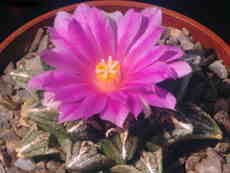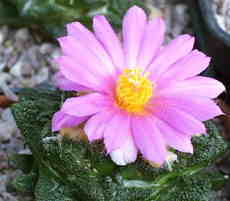|
Original
Publication
Ariocarpus fissuratus var.
hintonii Stuppy, W. & Taylor, N.P. (1989) Bradleya 7:
84-88.
The plant was transferred to sub specific
rank under A. bravoanus by Anderson and Fitz Maurice in
1997.
Ariocarpus bravoanus subsp.
hintonii Anderson E.F. & Fitz Maurice W.A. (!997)
Haseltonia 5: 1-20.
|
Description
Stem to 6cm~diam, rising no more than 1.5cm
above ground level in habitat, tubercles in 5:8 spirals, dark olive
green, total length of tubercles c 20mm, verrucose part of adaxial
surface 8-11mm long, 11-15mm wide, with a central, woolly areolar
groove and two very distinct, perfectly straight, glabrous lateral
grooves 0.5-1.0mm wide, remainder densely and finely verrucose,
with a pale, almost crystalline appearance, edges acute not
rounded, the tubercles nearly triangular in cross section, apex
acute and well-defined Flowers c 3.5 x 4cm, pinkish magenta Fruit
2O x 5mm, pale red. Seeds 1.1-1.4(-1.5) x O.95 -1.2mm, testa black,
tuberculate.
|
|

A bravoanus hintonii flowering in
August, it is frequently the earliest species of the genus to
bloom in cultivation.
|
Distribution (Map)
Of limited distribution, being known from
two locations 10 and 35km to the South of Matehuala in Northern San
Luis Potosi, at circa 1600m altitude on gravelly limestone
slopes.

A. bravoanus hintonii, a
grafted plant flowering for the first time, the central fissure
develops with maturity.
|
|
Comments
Ariocarpus bravoanus subsp. hintonii is superficially similar to a three
fissured A. fissuratus of the Northern type. It is however
geographically remote from these plants, and possesses a totally
different epidermal structure. The relationship to A.
bravoanus is much closer and this has prompted Anderson to
place A. hintonii as a sub-species of A. bravoanus
rather than as a variety of A. fissuratus,. Indeed some
plants in the A. bravoanus habitat have a marked resemblance
to A. hintonii and, as commented on under A.
bravoanus, these two may well represent extremes of the same
species. The tubercles of both sub-species are considerably taller
than those of A. fissuratus. Ariocarpushintonii is one earliest plants of the genus to flower in
cultivation. This early flowering makes it easy to set seed on, at
least in the UK where lower autumnal temperatures seem to reduce
pollen release and acceptance. in the later part of the flowering
season.
|
Field
Numbers
A full listing of all associated field
collector data can be found on our field
number reference pages.
|